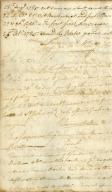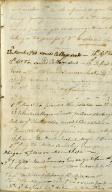[ Gout ] Henry Nase
Date: The recipes appear between the diary entries for 19 December 1785 and 22 March 1786. | 1785/12/19 to 1786/03/22
Source:
Diary of Henry Nase
Institution: New Brunswick Museum Archives and Research Library
| Source Origin: Nase Family Papers
| Sublocation: Diary of Henry Nase
| Reference: S 116-2 - F 4
This recipe appears on page 97. Image courtesy of New Brunswick Museum Archives and Research Library.
Gout
Four ounces leaves of speedwell Two ounces alder
Bark -- 3do wintris bark ½ pd angelica root
4 ounces Fennel Bark boil these together in 2 gal[ons] of
soft water, strain the decoction in a earthen Pan, let
it stand all night to settle. Pour it off in the morning
and disolve 3.tb treble refined sugar; Two p.d virgin
honey – gently simmered into a thin syrup – a larger
teacup full, night & morning – to each dose or time of
taking, a teaspoonful of Dr. Huxham’s essense of antimony
Download: Transcription | Images

